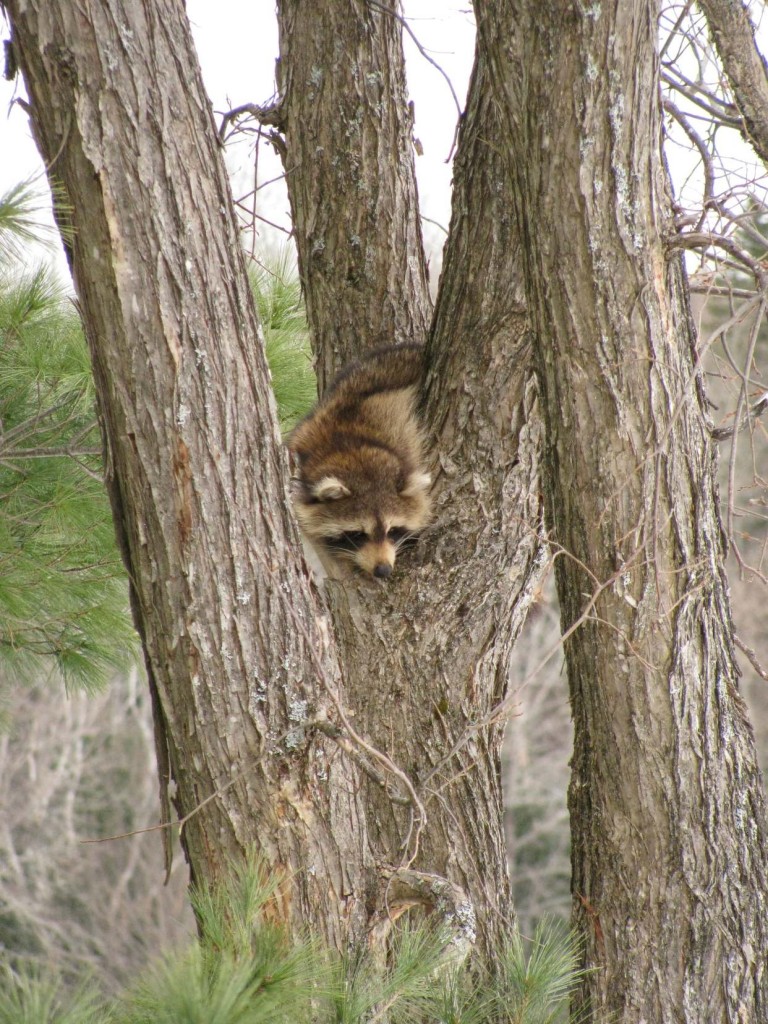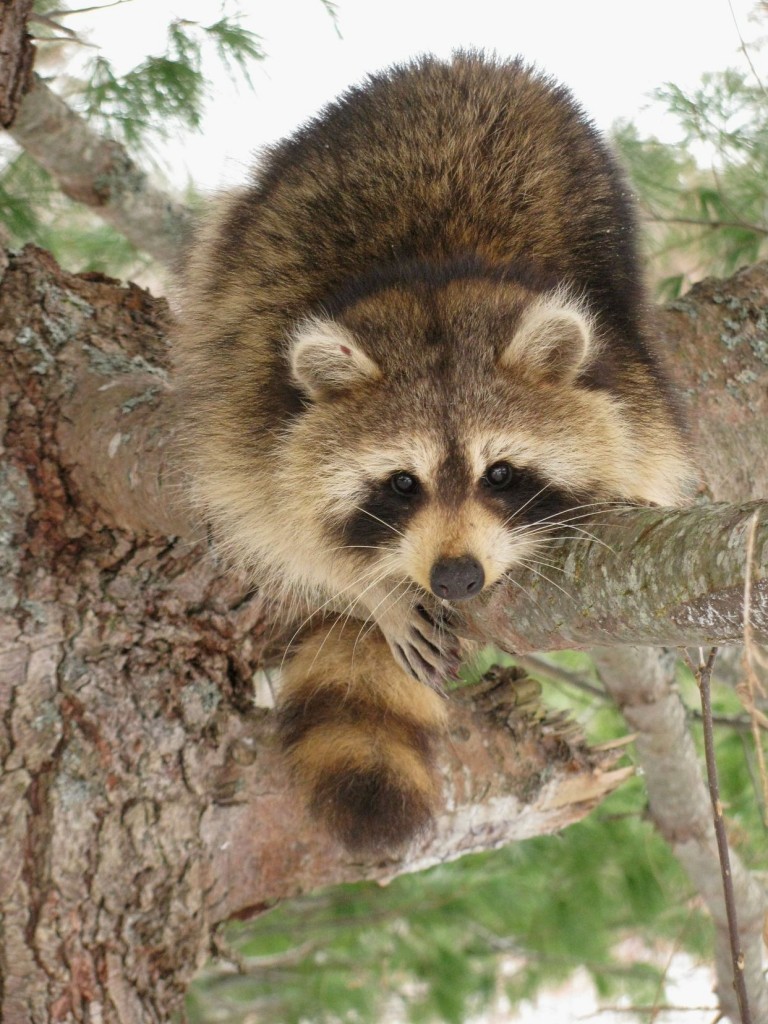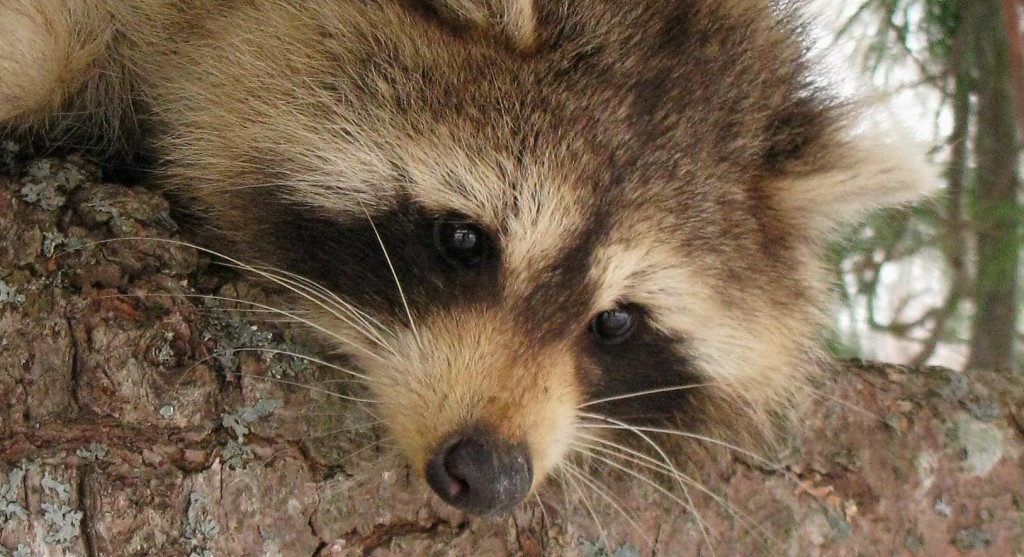
Raccoon (© Magi Nams)
I ran this morning, with frost on the ground, the air sweet and cold, and bird talk splitting the silence. A blue jay voiced its ringing call, an American robin sang ‘cheeriup-cheerio-cheeriup’, and a white-throated sparrow whistled a tentative ‘O-sweet-Canada-Canada.’ I heard my first yellow-rumped warbler of the season two evenings ago, and on the return leg of this morning’s run, spotted a palm warbler trilling lustily from atop a bare maple. I ‘psshed’ to it, and like a gift tossed onto my early morning plate, it flew to within a few metres of me, offering a close-up view of its saffron breast and rusty cap. Bolting temperatures and strong winds warming and drying northern Nova Scotia during the past two weeks have resulted in a delightfully early spring (the antithesis of last year’s cold, wet weather that lingered into July) marked by the arrival of new migratory songbirds every day, willows and maples blooming, and my flower beds calling for attention. Today’s post, however, is about none of these. It’s about raccoons.

Raccoon in Elm Tree (© Magi Nams)
I grew up on a grain and livestock farm in Alberta and never saw a raccoon until I moved east to Nova Scotia to do a Master’s degree at Dalhousie University. My family eventually took up permanent residence in northern Nova Scotia, and I’ve since become very familiar with these masked bandits, which are the only Canadian member of the raccoon family Procyonidae. Raccoon relatives include South American forest-dwelling kinkajous and American southwest dry country coatimundis and ringtails. Members of the raccoon family all possess long tails (some prehensile) and agile forepaws, the latter capable of delicate manipulations. Most procyonids are medium-sized, with adult raccoons being the size of an obese cat, and most are nocturnal in their habits, as the raccoon generally is.1 I took the photos for this post at dusk and in early morning.
Raccoons are forest dwellers and always live near water, in which they often wash their food.1 Since our property is partially forested and has a brook running through it, we’re in prime raccoon habitat. Every year, we see coons around the yard and sometimes on our porch, their humped bodies seeming ungainly behind their pointed faces and delicate forepaws, their ringed tails bringing up the rear. When I step out the door to scare them off the porch, they lunge into motion, moving surprisingly quickly. They’re agile climbers, using their long, sharp claws to aid them in scaling trees. They’re also vicious in a fight and incredibly strong for their size. Years ago, when Vilis was live-trapping and radio-collaring skunks in southern Manitoba to study their hunting habits, we occasionally caught raccoons in the box traps, which were constructed of heavy plywood and rigid wire mesh. The skunks never once damaged the traps. The raccoons tore the trap interiors to shreds.

Raccoon in Pine Tree (© Magi Nams)
Raccoons are omnivores, feeding on whatever they can catch and harvest, including beetles and grubs, fish and crabs, birds and small mammals, fruits, acorns, and berries.1 I’ve found their scats filled with blackberry seeds, and their hand-like tracks near chewed sweet corn cobs in my garden. They’re particularly fond of chicken, as Vilis and I have discovered over the years. I’ve been awakened in the night by the death screams of a rooster attacked by a coon that squeezed into our chicken coop, and Vilis has had to butcher Meat Kings missing wings or chunks of back flesh torn off by raccoons that reached in through the wire sides of an outdoor portable pen to rip into the sleeping chickens.
Tests have shown that raccoons are smarter than cats, but not as smart as monkeys. Their ability to capture and deal with such a wide variety of food items requires problem-solving skills and the ability to learn to deal with novel situations.1 I think Vilis and I have been supplying a testing ground for those abilities, with the raccoons coming out on top more times than we would like.

Raccoon (© Magi Nams)
Reference:
1. Adrian Forsyth. Mammals of the Canadian Wild, 1985. Camden House Publishing Limited, Camden East, Ontario, pp. 142-145.


